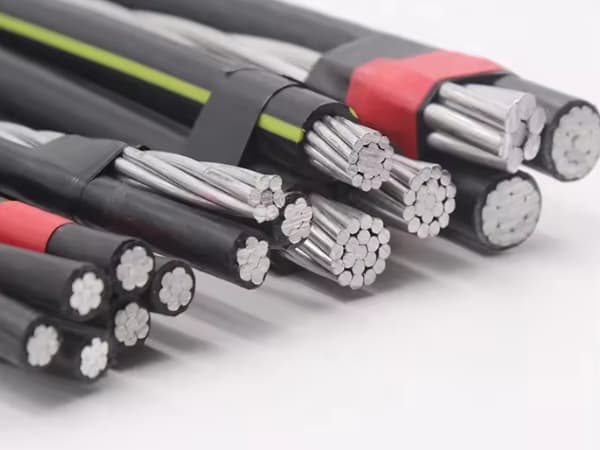
Overhead electrical cables are crucial components of modern power distribution networks. They serve as the lifeline for transmitting electricity from power plants to homes, businesses, and industries. 이 기사에서는, we will delve into the various aspects of overhead cables, 그들의 유형을 포함하여, uses, 장점, and maintenance. Our discussion will particularly focus on key terms like overhead cables, overhead earth wire, overhead electric cables to house, and overhead ground wire.
What are Overhead Electrical Cables?
Overhead electrical cables are conductors that are suspended above the ground by poles or towers. These cables are used to transmit electrical power over long distances. The primary purpose of overhead cables is to ensure the efficient and safe delivery of electricity to different points along the distribution network.
Types of Overhead Electrical Cables
- Bare Conductors:
- 알루미늄 도체 강철 강화 (ACSR): These are widely used due to their high tensile strength and lightweight properties. ACSR cables consist of a core of steel strands surrounded by aluminum strands.
- All-Aluminum Alloy Conductors (AAAC): These cables are made entirely of aluminum alloy, which provides better conductivity and resistance to corrosion.
- Insulated Cables:
- 공중 번들 케이블 (알파벳): These cables are used in densely populated areas where safety is a concern. They consist of several insulated phase conductors bundled together with an insulated neutral conductor.
- Overhead Earth Wire (OHEW):
- Also known as the shield wire or sky wire, the overhead earth wire is a critical component of the overhead transmission system. It provides protection against lightning strikes by safely conducting the induced current to the ground.
Overhead Electric Cables to House
When it comes to residential power supply, overhead electric cables to house play a vital role. These cables connect the main power lines to individual homes, ensuring a steady and reliable supply of electricity. The installation process involves running the cables from a nearby utility pole to a weatherhead on the house, from where the power is then distributed to the electrical panel.
Advantages of Overhead Electrical Cables
- Cost-Effective: Overhead cables are generally less expensive to install and maintain compared to underground cables. The infrastructure required for overhead lines, such as poles and towers, is more affordable than the extensive trenching needed for underground systems.
- Easier Maintenance: Since overhead cables are accessible, maintenance and repairs can be carried out more quickly and with less disruption. Faults in overhead lines are easier to detect and fix.
- 유연성: Overhead cables can be installed in a variety of terrains, including rough and uneven landscapes. This flexibility makes them suitable for both urban and rural areas.
- Cooling Effect: Being exposed to the air, overhead cables have a natural cooling mechanism, which helps in dissipating heat generated by the electrical current.
오버 헤드 접지선
The overhead ground wire, often used interchangeably with the overhead earth wire, is an essential component for protecting power lines. Its primary function is to shield the phase conductors from lightning strikes by providing a direct path to the ground for the lightning current.
Importance of Overhead Ground Wire
- Lightning Protection: By intercepting lightning strikes, the overhead ground wire prevents damage to the main conductors and associated equipment.
- System Stability: It enhances the stability and reliability of the power transmission system by reducing the risk of outages caused by lightning.
- Safety: The overhead ground wire helps in maintaining safety standards by preventing the buildup of dangerous voltages on the power lines.
Installation Process of Overhead Electrical Cables
- Planning and Surveying: The installation of overhead cables begins with thorough planning and surveying of the route. This step involves identifying the best path for the cables, taking into account factors like terrain, environmental impact, and proximity to existing infrastructure.
- Erecting Poles or Towers: The next step is the erection of poles or towers that will support the overhead cables. The height and spacing of these structures are determined based on the voltage level and the type of cables being used.
- Stringing the Cables: Once the support structures are in place, the cables are carefully strung between them. This process requires precision to ensure that the cables are properly tensioned and aligned.
- Securing the Cables: The final step involves securing the cables to the poles or towers using insulators and other hardware. This ensures that the cables remain stable and can withstand environmental stresses.
Maintenance Practices Overhead Electrical Cables
Regular maintenance of overhead cables is essential to ensure their longevity and reliability. Some key maintenance practices include:
- Inspection: Periodic inspection of the cables and support structures helps in identifying potential issues like corrosion, wear and tear, or damage from external factors.
- Vegetation Management: Keeping the area around the cables clear of vegetation is crucial to prevent outages caused by trees and branches coming into contact with the cables.
- Repair and Replacement: Any damaged or worn-out components should be promptly repaired or replaced to prevent further deterioration and potential failures.
- Testing: Regular testing of the electrical properties of the cables helps in monitoring their performance and detecting any anomalies that may indicate underlying problems.
Conclusion Overhead Electrical Cables
Overhead electrical cables are indispensable for modern power distribution systems. Their cost-effectiveness, ease of maintenance, and flexibility make them a preferred choice for transmitting electricity over long distances. Understanding the various aspects of overhead cables, including the role of overhead earth wires and ground wires, is essential for ensuring a stable and reliable power supply.
Whether it’s for residential connections or large-scale power transmission, overhead cables continue to play a pivotal role in powering our world. By following best practices in installation and maintenance, we can ensure the longevity and efficiency of these critical components of our electrical infrastructure.
